A Process Mineralogical Evaluation of Chromite at the Nkomati Nickel Mine, Uitkomst Complex, South Africa
Abstract
1. Introduction
2. Geological Background
3. Technological Approach at Nkomati Nickel Mine
4. Materials and Methods
4.1. Samples
4.2. Experimental Procedure
4.2.1. Flotation Test Work
4.2.2. Gravity Separation
4.3. Analytical Methods
5. Results
5.1. Mineralogy and Textures
5.2. Chromite Chemistry
5.3. Metallurgical Test Work
5.3.1. Milling Curves
5.3.2. Gravity Separation Test Work
5.3.3. Assays and Recoveries of Chromite
5.4. Quantitative Mineralogy: Modal Mineralogy and Chromite Grain Size Distributions
5.4.1. Modal Mineralogy
5.4.2. Chromite Grain Size Distributions
5.4.3. Particle Density Distributions
5.4.4. Chromite Liberation
6. Discussion
6.1. Chromite Chemistry
6.2. Milling Performances of the Three Nkomati Mine Ores
6.3. Implications for Chromite Ore Processing
7. Conclusions
- A fine grind size is not optimal for processing PCMZ ores. This implies that the target grind (particle size) is more important than liberation.
- Increased milling of the ore to finer grinds does not result in improved chromite recoveries or grades for the PCMZ ores. The chromite chemistry controls the recovery of chromite.
- Increased milling of the ore to finer grinds results in improved chromite recoveries or grades for the MCHR ores, particularly the MCHR_FT ore.
- The MCHR_FT ore performed better than the MCHR_FO ore. This holds promise for blending of the PCMZ ores with the MCHR ore. This would involve blending of the MCHR with the PCMZ ore prior to flotation with the flotation tailings being feed for the chrome plants.
- The P80 of 75 μm grind size is the most optimal grind size to process all three ore types.
Author Contributions
Funding
Acknowledgments
Conflicts of Interest
References
- Dawson, N.F. Experiences in the production of metallurgical and chemical grade UG2 chromite concentrates from PGM tailings streams. J. S. Afr. Inst. Min. Metall. 2010, 110, 683–690. [Google Scholar]
- Murthy, Y.R.; Tripathy, S.K.; Kumar, C.R. Chrome ore beneficiation challenges & opportunities—A review. Miner. Eng. 2011, 24, 375–380. [Google Scholar]
- Freire, L.A.; Leite, J.Y.P.; da Silva, D.N.; da silva, B.G.; Oliveira, J.C.S. Behaviour of the chromite tailings in a centrifugal concentrator (FALCON). Rem Rev. Esc. Minas 2019, 72, 147–152. [Google Scholar]
- Tripathy, S.K.; Murthy, Y.R.; Singh, V.; Farrokhpay, S.; Filippov, L.O. Improving the quality of ferruginous chromite concentrates via physical separation methods. Minerals 2019, 9, 667. [Google Scholar] [CrossRef]
- Nafzinger, R.H. A review of the deposits and beneficiation of lower grade chromite. J. S. Afr. Inst. Min. Metall. 1982, 82, 205–226. [Google Scholar]
- Cousins, C.A. Additional notes on the chromite deposits of the Eastern part of the Bushveld Complex. In The Geology of Some ore Deposits of Southern Africa; Haughton, S.H., Ed.; Geological Society of South Africa: Johannesburg, South Africa, 1964; p. 750. [Google Scholar]
- Cousins, C.A.; Feringa, G. The chromite deposits of the Western belt of the Bushveld Complex. In The Geology of Some ore Deposits of Southern Africa; Haughton, S.H., Ed.; Geological Society of South Africa: Johannesburg, South Africa, 1964; p. 750. [Google Scholar]
- Cameron, E.N. Chromite in the Central sector of the eastern Bushveld Complex, South Africa. Am. Mineral. 1977, 62, 1082–1096. [Google Scholar]
- Von Gruenewaldt, G.; Hatton, C.J.; Merkle, R.K.W.; Gain, S.B. Platinum-group element–chromitite associations in the Bushveld Complex. Econ Geol. 1986, 81, 1067–1079. [Google Scholar] [CrossRef]
- Teigler, B.; Eales, H.V. Correlation between chromite composition and PGE mineralization in the Critical Zone of the western Bushveld Complex. Miner Deposita 1993, 28, 291–302. [Google Scholar] [CrossRef]
- Scoon, R.N.; Teigler, B.A. New LG-6 chromitite reserve at Eerste Geluk in the boundary zone between the Central and Southern Sectors of the Eastern Bushveld Complex. Econ Geol. 1995, 90, 969–982. [Google Scholar] [CrossRef]
- Teigler, B. Chromite chemistry and platinum-group element distribution of the LG6 chromitite, northwestern Bushveld Complex. S. Afr J. Geol. 1999, 102, 282–285. [Google Scholar]
- Eales, H.V. Implications of the chromium budget of the Western Limb of the Bushveld Complex. S. Afr. J. Geol. 2000, 103, 141–150. [Google Scholar] [CrossRef]
- Kinnaird, J.A.; Kruger, F.J.; Nex, P.A.M.; Cawthorn, R.G. Chromitite formation–a key to understanding processes of platinum enrichment. Appl. Earth Sci. 2002, 111, 23–35. [Google Scholar] [CrossRef]
- Mondal, S.K.; Mathez, E.A. Origin of the UG2 chromitite layer, Bushveld Complex. J. Petrol. 2007, 48, 495–510. [Google Scholar] [CrossRef]
- Kottke-Levin, J.; Tredoux, M.; Gräbe, P.-J. An investigation of the geochemistry of the Middle Group of the eastern Bushveld Complex, South Africa. Part 1–the chromitite layers. Appl. Earth Sci. 2009, 118, 111–130. [Google Scholar] [CrossRef]
- Naldrett, A.J.; Kinnaird, J.; Wilson, A.; Yudovskaya, M.; McQuade, S.; Chunnett, G.; Stanley, C. Chromite composition and and PGE content of Bushveld chromitites: Part 1–the lower and middle groups. Trans. Inst. Metall. B 2009, 118, 131–161. [Google Scholar] [CrossRef]
- Naldrett, A.J.; Wilson, A.; Kinnaird, J.; Yudovskaya, M.; Chunnett, G. The origin of chromites and related PGE mineralization in the Bushveld Complex: New mineralogical and petrological contraints. Miner. Depos. 2012, 47, 209–232. [Google Scholar] [CrossRef]
- Junge, M.; Oberthür, T.; Melcher, F. Cryptic variationof chromite chemistry, platinum group element and platinum group mineral distribution in the UG-2 chromitite: An example from the Karee mine, Western Bushveld Complex, South Africa. Econ. Geol. 2014, 109, 795–810. [Google Scholar] [CrossRef]
- Bachmann, K.; Menzel, P.; Tolosana-Delgado, R.; Schmidt, C.; Hill, M.; Gutzmer, J. Multivariate geochemical classification of chromitite layers in the Bushveld Complex, South Africa. Appl. Geochem. 2019, 102, 106–117. [Google Scholar] [CrossRef]
- Langa, M.M.; Jugo, P.J.; Leybourne, M.I.; Grobler, D.F.; Adetunji, J.; Skogby, H. Chromite chemistry of a massive seam in the Northern Limb of the Bushveld Igneous Complex, South Africa: Correlation with the UG-2 in the eastern and western limbs and evidence of variable assimilation of footwall rocks. Miner. Depos. 2020, in press. [Google Scholar] [CrossRef]
- Tripathy, S.K.; Singh, V.; Ramamurthy, Y. Improvement in Cr: Fe ratio of Indian chromite ore for ferro chrome production. Int. J. Min. Eng. Miner. Process. 2012, 1, 101–106. [Google Scholar]
- Lastra, R. Seven practical application cases of liberation analysis. Int. J. Miner. Process. 2007, 84, 337–347. [Google Scholar] [CrossRef]
- Dai, Z.; Bos, J.; Lee, A.; Wells, P. Mass balance and mineralogical analysis of flotation plant survey samples to improve plant metallurgy. Miner. Eng. 2008, 21, 826–831. [Google Scholar] [CrossRef]
- Tomanec, R.; Cablik, V.; Simovic, I.; Gacina, R. Ore microscopy characterization as a mineral processing control. inzynieria mineralna-LIPIEC-GRUDZIEN. J. Pol. Miner. Eng. Soc. 2014, 2, 101–106. [Google Scholar]
- Little, L.; Becker, M.; Wiese, J.; Mainza, A. Auto-SEM particle shape characterisation: Investigating fine grinding of UG2 ore. Miner. Eng. 2015, 82, 92–100. [Google Scholar] [CrossRef]
- Gottlieb, P.; Wilkie, G.; Sutherland, D.; Ho-Tun, E.; Suthers, S.; Perera, K.; Jenkins, B.; Spencer, S.; Butcher, A.; Rayner, J. Using quantitative electron microscopy for process mineralogy applications. J. Miner. Met. Mater. Soc. 2000, 52, 24–25. [Google Scholar] [CrossRef]
- Gu, Y. Automated scanning electron based mineral liberation analysis. J. Miner. Mater. Charact. Eng. 2003, 2, 33–41. [Google Scholar]
- Fandrich, R.; Gu, Y.; Burrows, D.; Moeller, K. Modern SEM-based mineral liberation analysis. Int. J. Miner. Proc. 2007, 84, 310–320. [Google Scholar] [CrossRef]
- Lotter, N.O.; Kormos, L.J.; Oliveira, J.; Fragomeni, D.; Whiteman, E. Modern Process Mineralogy: Two Case studies. Miner. Eng. 2011, 24, 638–650. [Google Scholar] [CrossRef]
- Young, M.F.; Pease, J.D.; Johnson, N.W.; Munro, P.D. Developments in Milling Practice at the Lead/Zinc Concentrator of Mount Isa Mines Limited. In Proceedings of the AusIMM Sixth Mill Operators Conference, Madang, Papua New Guinea, 6–8 October 1997; pp. 1–19. [Google Scholar]
- Mulaba-Bafubiandi, A.F.; Medupe, O. An assessment of pentlandite occurrence in the run of mine ore from BCL Mine (Botswana) and its impact on the flotation yield. The Southern African Institute of Mining and Metallurgy. In Proceedings of the Fourth Southern African Conference on Base Metals—‘Africa’s Metals Resurgence, Swakopmund, Namibia, 23–27 July 2017; pp. 57–75. [Google Scholar]
- Wabo, H.; Olsson, J.R.; de Kock, M.O.; Humbert, F.; Söderlund, U.; Klausen, M.B. New U-Pb age and paleomagnetic constraints from the Uitkomst Complex, South Africa: Clues to timing of intrusion. GFF 2016, 138, 152–163. [Google Scholar] [CrossRef]
- Maier, W.D.; Prevec, S.A.; Scoates, J.S.; Wall, C.J.; Barnes, S.-J.; Gomwe, T. The Uitkomst intrusion and Nkomati Ni-Cu-PGE deposit, South Africa: Trace element geochemistry, Nd isotopes and high-precision geochronology. Miner. Depos. 2018, 53, 67–88. [Google Scholar] [CrossRef]
- Barnes, S.J.; Cruden, A.R.; Arndt, N.; Saumur, B.M. The mineral system approach applied to magmatic Ni-Cu-PGE sulphide deposits. Ore Geol. Rev. 2016, 76, 296–316. [Google Scholar] [CrossRef]
- Yudovskaya, M.A.; Naldrett, A.J.; Woolfe, J.A.S.; Costin, G.; Kinnaird, J.A. Reverse compositional zoning as an indicator of crystallization in a magmatic conduit. J. Petrol. 2016, 56, 2373–2394. [Google Scholar] [CrossRef]
- Theart, H.F.J.; De Nooy, C.D. The platinum group minerals in two parts of the Massive sulphide Body of the Uitkomst Complex, Mpumalanga, Africa. S. Afr. J. Geol. 2001, 104, 287–300. [Google Scholar] [CrossRef]
- Wagner, P.A. The Platinum Deposits and Mines of South Africa; Oliver and Boyd: Edinburgh, UK, 1929. [Google Scholar]
- De Waal, S.A.; Maier, W.D.; Armstrong, R.A.; Gauert, C.D.K. Parental magma and emplacement of the stratiform Uitkomst Complex, South Africa. Can Mineral. 2001, 39, 557–571. [Google Scholar] [CrossRef]
- Cockburn, G. Challenges and successes at the Nkomati JV: Pit-to-product process improvements. In Proceedings of the 7th Southern African Base Metals Conference, White River, South Africa, 2–6 September 2013; South African Institute of Mining and Metallurgy: Mpumalanga, South Africa, 2013; pp. 151–167. [Google Scholar]
- Bradford, L.; McInnes, C.; Stange, W.; de Beer, C.; David, D.; Jardin, A. The development of the proposed milling circuit for the Nkomati main concentrator plant. Miner. Eng. 1998, 11, 1103–1117. [Google Scholar] [CrossRef]
- Newell, A.J.H.; Bradshaw, D.J. The development of a sulfidisation technique to restore the flotation of oxidised pentlandite. Miner. Eng. 2007, 20, 1039–1046. [Google Scholar] [CrossRef]
- Becker, M.; de Villiers, J.; Bradshaw, D. The flotation of magnetic and non-magnetic pyrrhotite from selected nickel ore deposits. Miner. Eng. 2010, 23, 1045–1052. [Google Scholar] [CrossRef]
- Ekmekçi, Z.; Becker, M.; Tekes, E.B.; Bradshaw, D. The relationship between the electrochemical, mineralogical and flotation characteristics of pyrrhotite sampls from different Ni ore. J. Electroanal. Chem. 2010, 647, 133–143. [Google Scholar] [CrossRef]
- Marape, G.; Vermaak, M.K.G. Fundamentals of pentlandite mineralogy and its effect on its electrochemical behaviour. Miner. Eng. 2012, 32, 60–67. [Google Scholar] [CrossRef]
- Chimbganda, T.; Becker, M.; Broadhurst, J.L.; Harrison, S.T.L.; Franzidis, J.-P. A comparison of pyrrhotite rejection and passivation in two nickel ores. Miner. Eng. 2013, 46–47, 38–44. [Google Scholar] [CrossRef]
- Mishra, G.; Viljoen, K.S.; Mouri, H. Influence of mineralogy and ore texture on pentlandite flotation at the Nkomati nickel mine, South Africa. Miner. Eng. 2013, 54, 63–78. [Google Scholar] [CrossRef]
- Ngobeni, W.A.; Hangone, G. The effect of using sodium di-methyl-dithiocarbamate as a co-collector with xanthates in the froth flotation of pentlandite containing ore from Nkomati mine in South Africa. Miner. Eng. 2013, 54, 94–99. [Google Scholar] [CrossRef]
- Bowers, R.L.; Smit, D.S. Process development of the Nkomati PCMZ base metals sulphide deposit. In Proceedings of the 4th Southern African Base Metals Conference, Swakopmund, Namibia, 23–27 July 2007; South African Institute of Mining and metallurgy: Swakopmund, Namibia, 2007; pp. 415–431. [Google Scholar]
- Gauert, C.D.K.; De Waal, S.A.; Wallmach, T. Geology of the ultrabasic Uitkomst Complex, eastern Transvaal, South Africa: An overview. J. Afr. Earth Sci. 1995, 21, 553–570. [Google Scholar] [CrossRef]
- Gauert, C. Sulphide and oxide mineralization in the Uitkomst Complex, South Africa: Origin in a magma conduit. J. Afr. Earth Sci. 2001, 32, 149–161. [Google Scholar] [CrossRef]
- Trubăc, J.; Ackerman, L.; Gauert, C.; Ďurišová, J.; Hrstka, T. Platinum-group elements and Gold in base metal sulfides, platinum-group minerals, and Re-Os isotope compositions of the Uitkomst Complex, South Africa. Econ. Geol. 2018, 113, 439–461. [Google Scholar] [CrossRef]
- Dzvinamurungu, T.; Viljoen, K.S.; Knoper, M.W.; Mulaba-Bafubiandi, A. Geometallurgical characterisation of Merensky Reef and UG2 at the Marikana mine, Bushveld Complex, South Africa. Miner. Eng. 2013, 52, 74–81. [Google Scholar] [CrossRef]
- English, B.L.; Desborough, G.A.; Raymond, W.H. A Mechanical Panning Technique for Separation of Fine-Grained Gold and Other Heavy Minerals; Open-File Report; United States Department of the Interior Geological Survey: Denver, CO, USA, 1987; Volume 87-0364, pp. 1–9. [Google Scholar]
- Mitchell, C.J.; Styles, M.T.; Evans, E.J. The Design, Construction and Testing of a Simple Shaking Table for Gold Recovery: Laboratory Testing and Field Trials; Technical Report WC\97\61; Overseas Geology Series; British Geological Survey: Nottingham, UK, 1997; pp. 1–27. [Google Scholar]
- Falconer, A. Gravity Separation: Old technique/new methods. Phys. Sep. Sci. Eng. 2003, 12, 31–48. [Google Scholar] [CrossRef]
- Wills, B.A. Wills’ Minerals Processing Technology: An Introduction to the Practical Aspects of Ore Treatment and Mineral Recovery, 7th ed.; Napier-Munn, T., Ed.; JKMRC; Elsevier Ltd.: Oxford, UK, 2006; pp. 267–344. [Google Scholar]
- Lougheed, H.D.; McClenaghan, M.B.; Layton-Matthews, D.; Leybourne, M. Exploration potential of fine-fraction heavy mineral concentrates from till using automated mineralogy: A case study from the Izok Lake Cu-Zn-Pb-Ag VMS deposit, Nunavut, Canada. Minerals 2020, 10, 310. [Google Scholar] [CrossRef]
- Rose, D.H.; Viljoen, K.S.; Mulaba-Bafubiandi, A. A mineralogical perspective on the recovery of platinum group elements from the Merensky Reef and UG2 at the Two Rivers mine on the Eastern Limb of the Bushveld Complex in South Africa. Miner. Petrol. 2018, 112, 881–902. [Google Scholar] [CrossRef]
- Whitney, D.L.; Evans, B.W. Abbreviations of names of rock-forming minerals. Am. Miner. 2010, 95, 185–187. [Google Scholar] [CrossRef]
- Barnes, S.J. The effect of trapped liquid crystallization on cumulus mineral compositions in layered intrusions. Contrib. Miner. Petrol. 1986, 93, 524–531. [Google Scholar] [CrossRef]
- Hay, M.P.; Roy, R. A case study of optimising UG2 flotation performance. Part 1: Bench, pilot, and plant scale factors which influence Cr2O3 entrainment in UG2 flotation. Miner. Eng. 2010, 23, 855–867. [Google Scholar] [CrossRef]
- Chayka, I.F.; Zhitova, L.M.; Antsiferova, T.N.; Abersteiner, A.; Shevko, A.Y.; Izokh, A.E.; Tolstykh, N.D.; Gora, M.P.; Chubarov, V.M.; Kamenetsky, V.S. In-situ crystallization and continuous modification of chromian spinel in the “sulfide-poor platinum-group metal ores” of the Norilsk-1 Intrusion (Northern Siberia, Russia). Minerals 2020, 10, 498. [Google Scholar] [CrossRef]
- Mekhonoshin, A.S.; Kolotilina, T.B.; Doroshkov, A.A.; Pikiner, E.E. Compositional variations of Cr-spinel in high-Mg intrusions of the primorsky ridge (Western Baikal Region, Russia). Minerals 2020, 10, 608. [Google Scholar] [CrossRef]
- Grieco, G.; Pedrotti, M.; Moroni, M. Metamorphic redistribution of Cr within chromitites and its influence on chromite ore enrichment. Miner. Eng. 2011, 24, 102–107. [Google Scholar] [CrossRef]
- Kimball, K.L. Effects of hydrothermal alteration on the composition of chromian spinels. Contrib. Miner. Petrol. 1990, 105, 337–346. [Google Scholar] [CrossRef]
- Barnes, S.J. Chromite in komatiites, II Modification during greenschist to mid-amphibolite facies metamorphism. J. Petrol. 2000, 41, 387–409. [Google Scholar] [CrossRef]
- Mellini, M.; Rumori, C.; Viti, C. Hydrothermally reset magmatic spinels in retrograde serpentinites, formation of “ferritchromit” rims and chlorite aureoles. Contrib. Miner. Petrol. 2005, 149, 266–275. [Google Scholar] [CrossRef]
- Wesseldijk, Q.I.; Reuter, M.A.; Bradshaw, D.J.; Harris, P.J. The flotation behaviour of chromite with respect to the beneficiation of UG2 ore. Miner. Eng. 1999, 12, 1177–1184. [Google Scholar] [CrossRef]
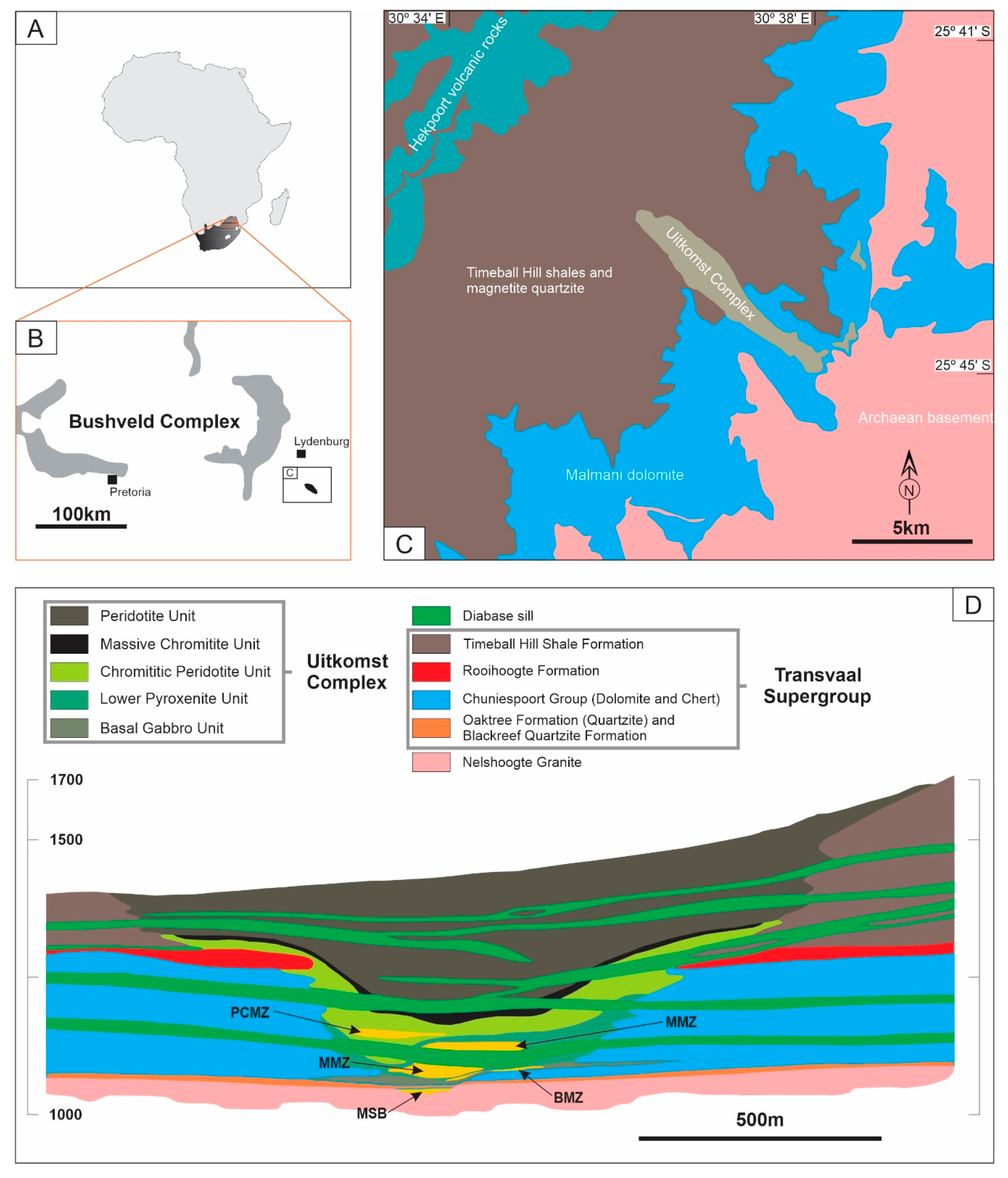
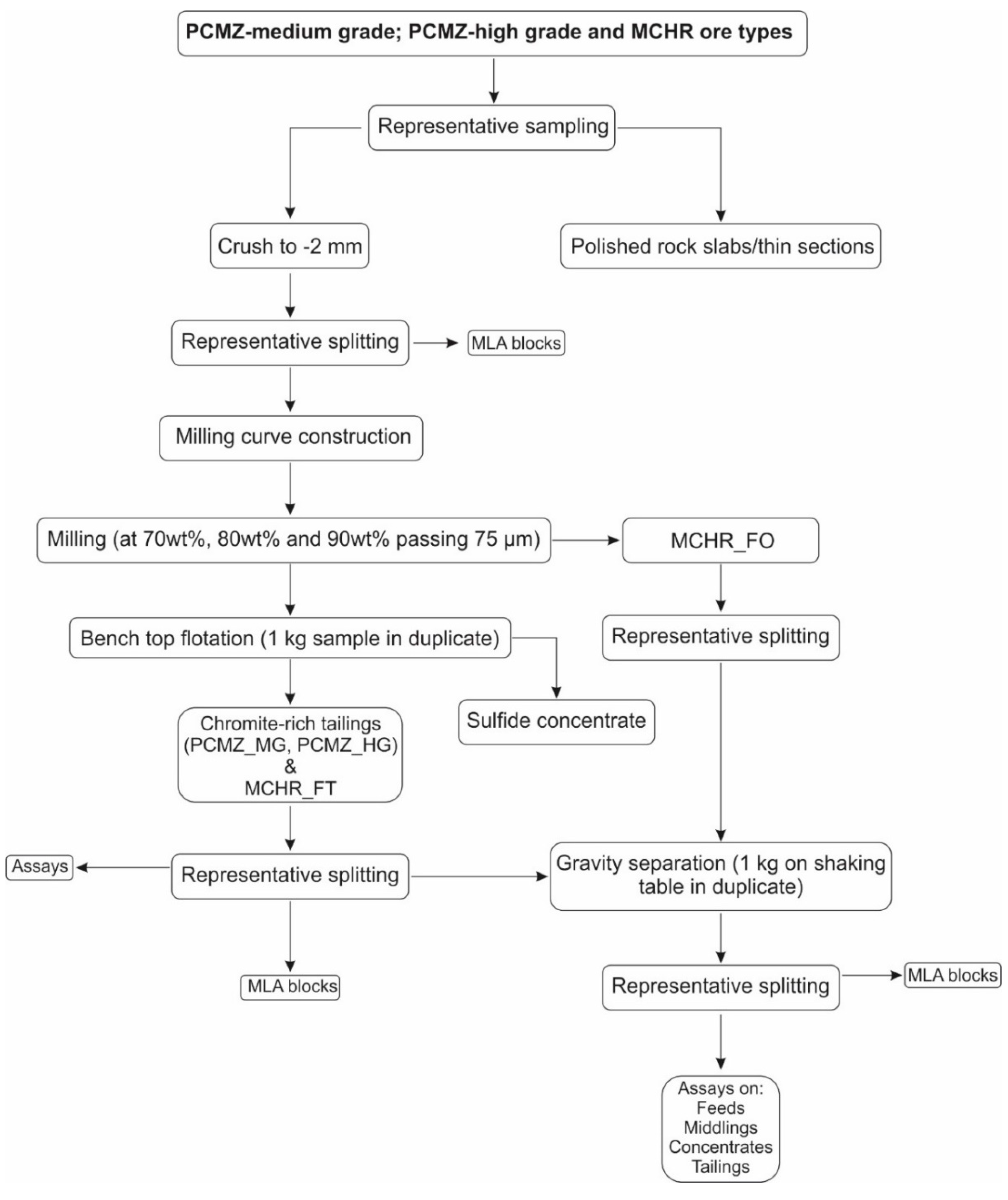
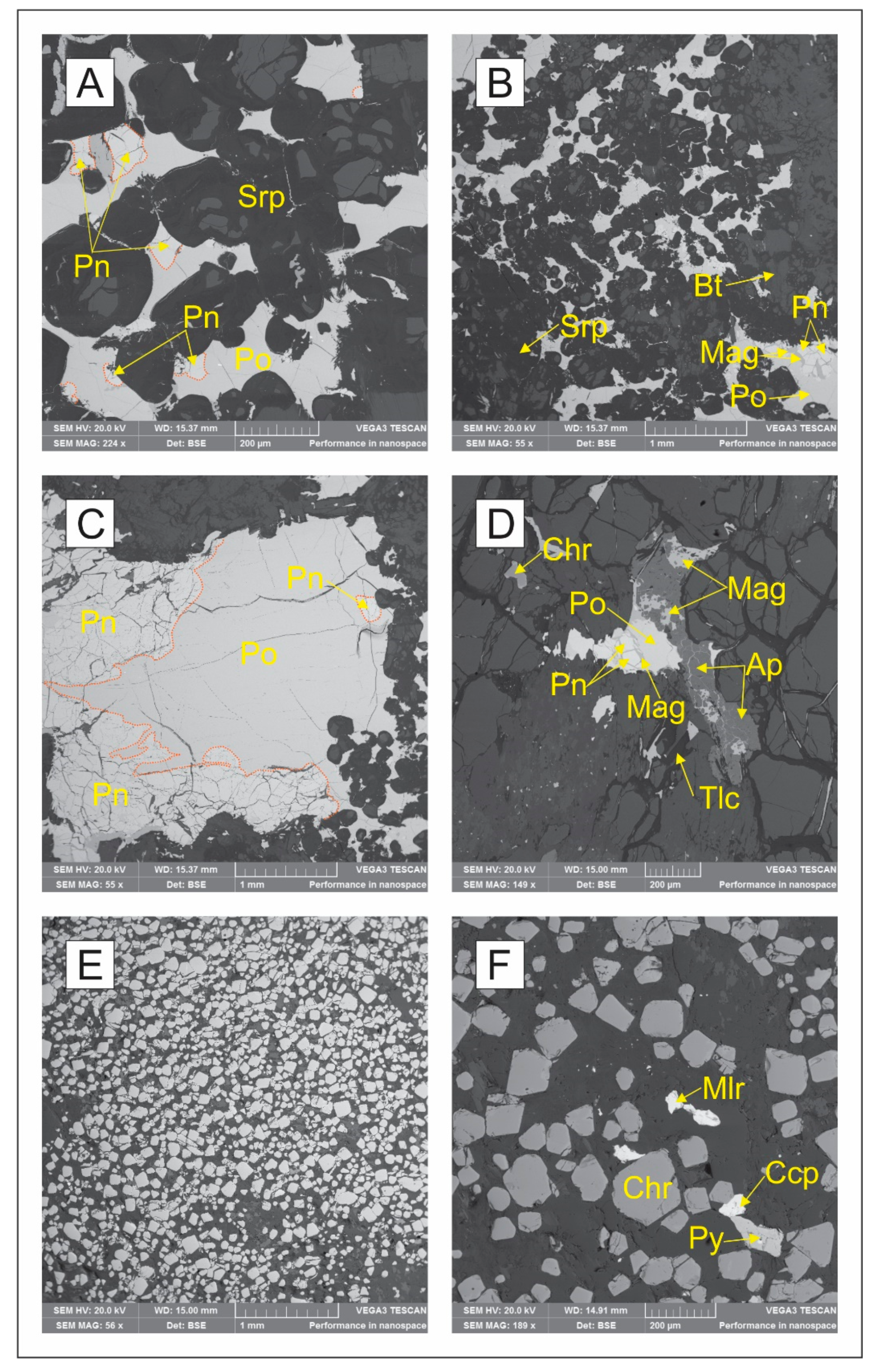
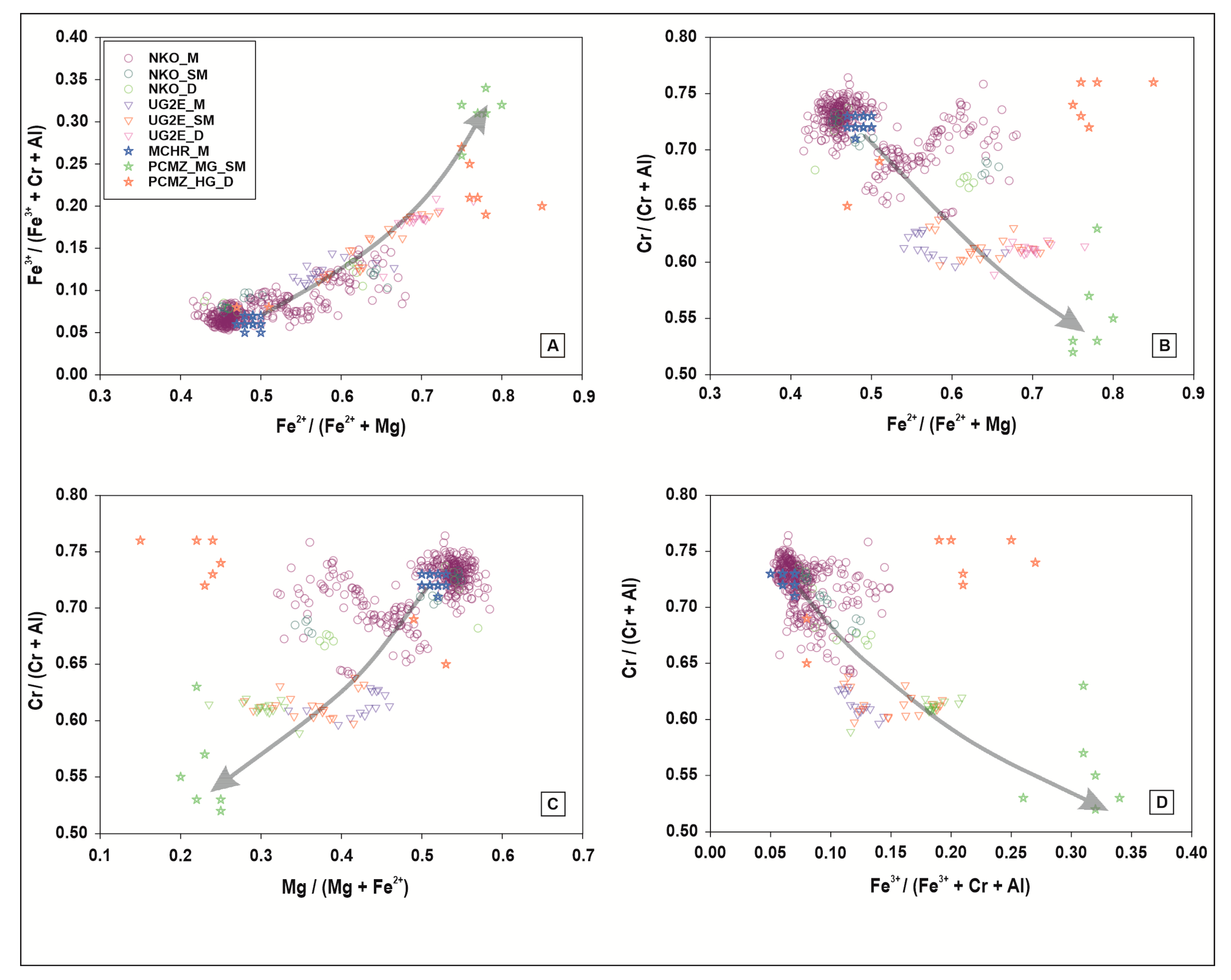
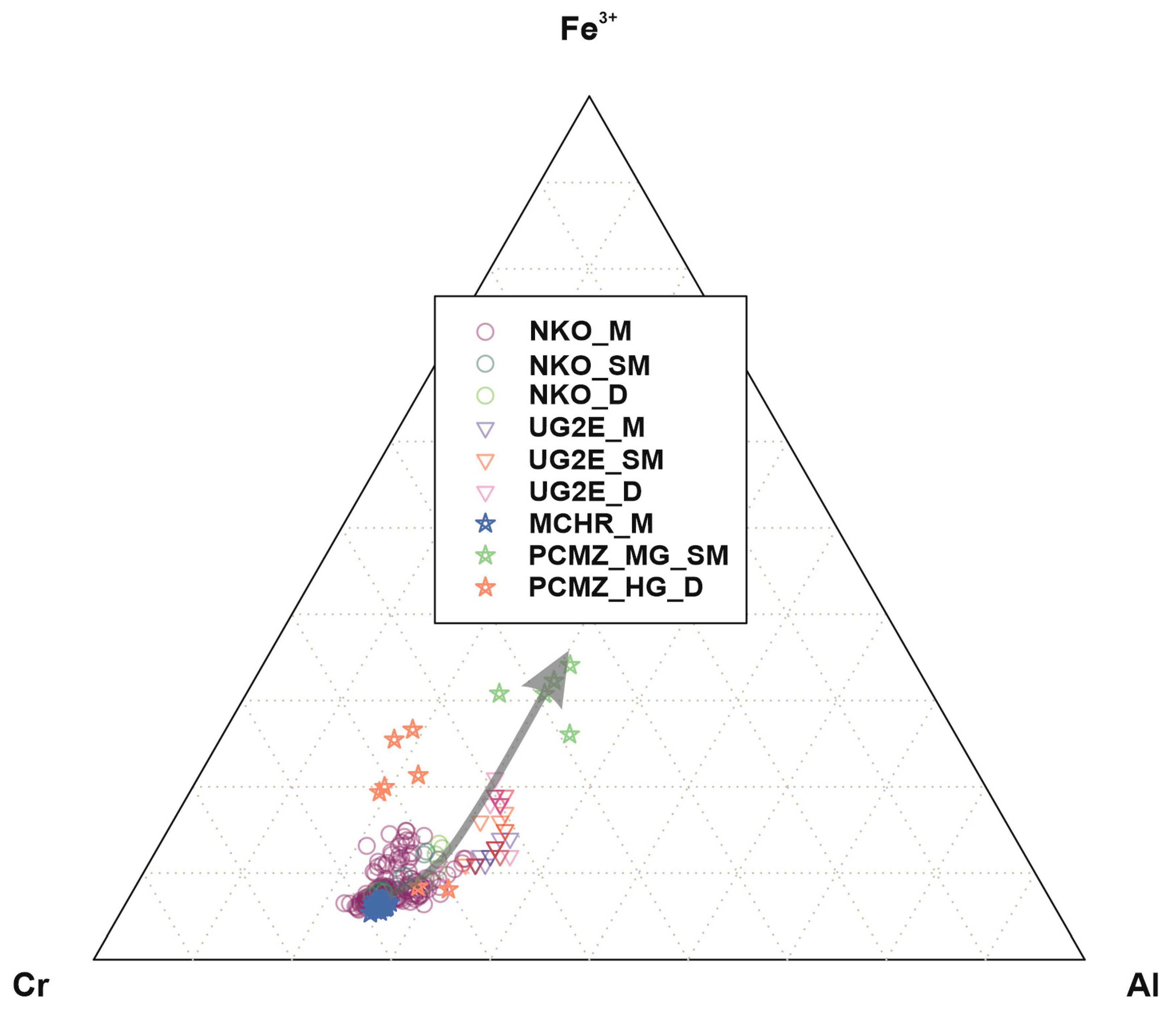
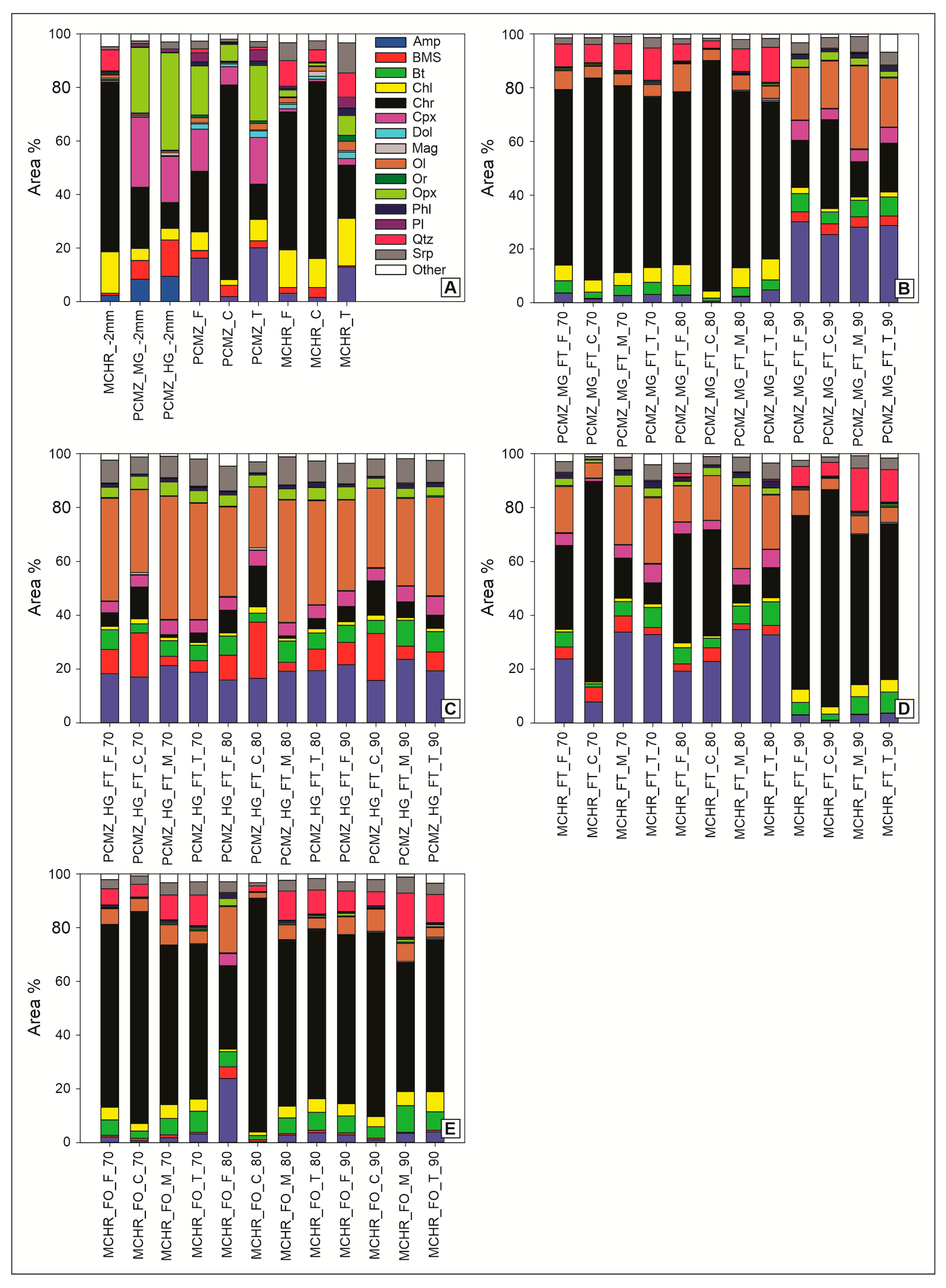
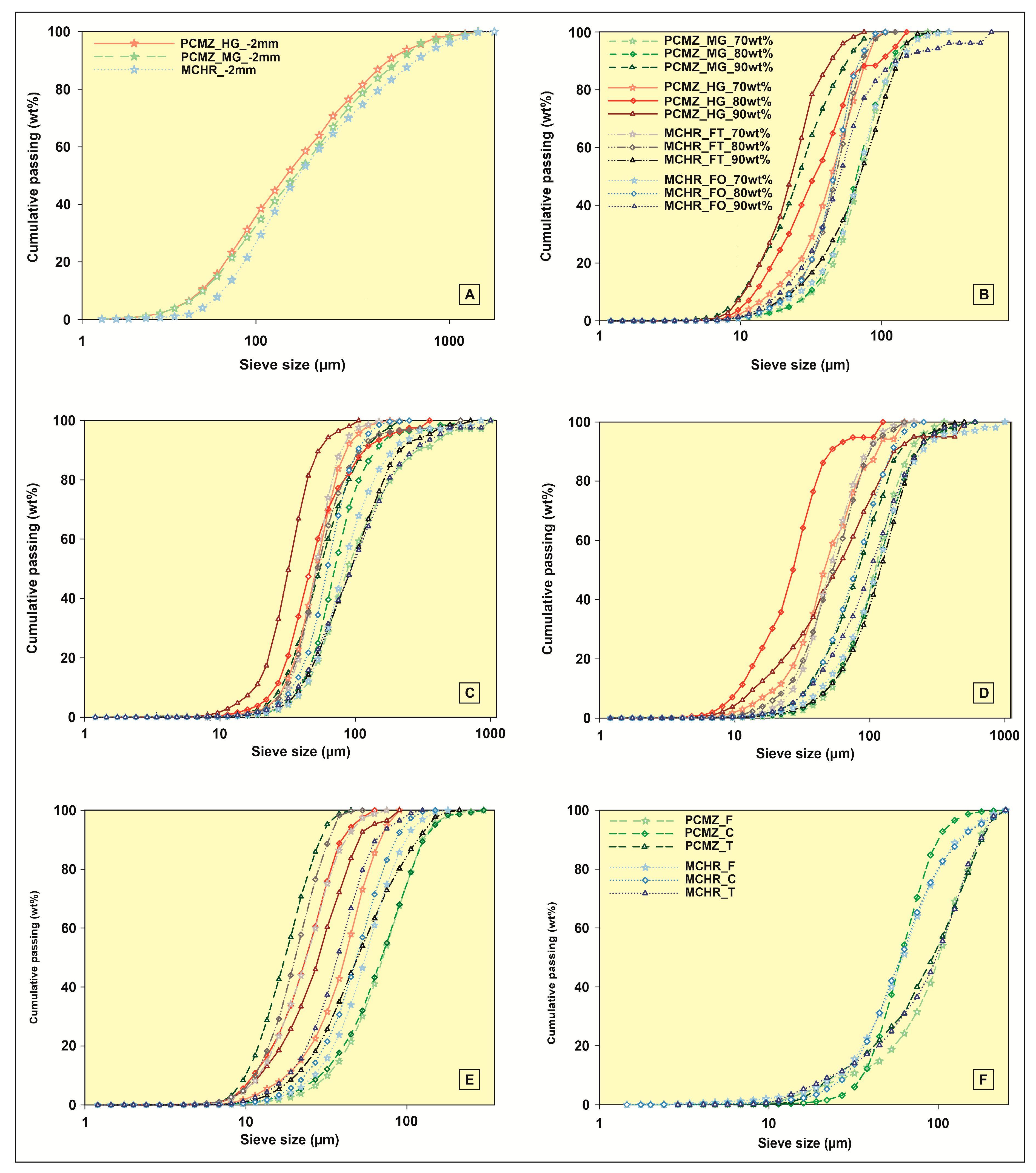
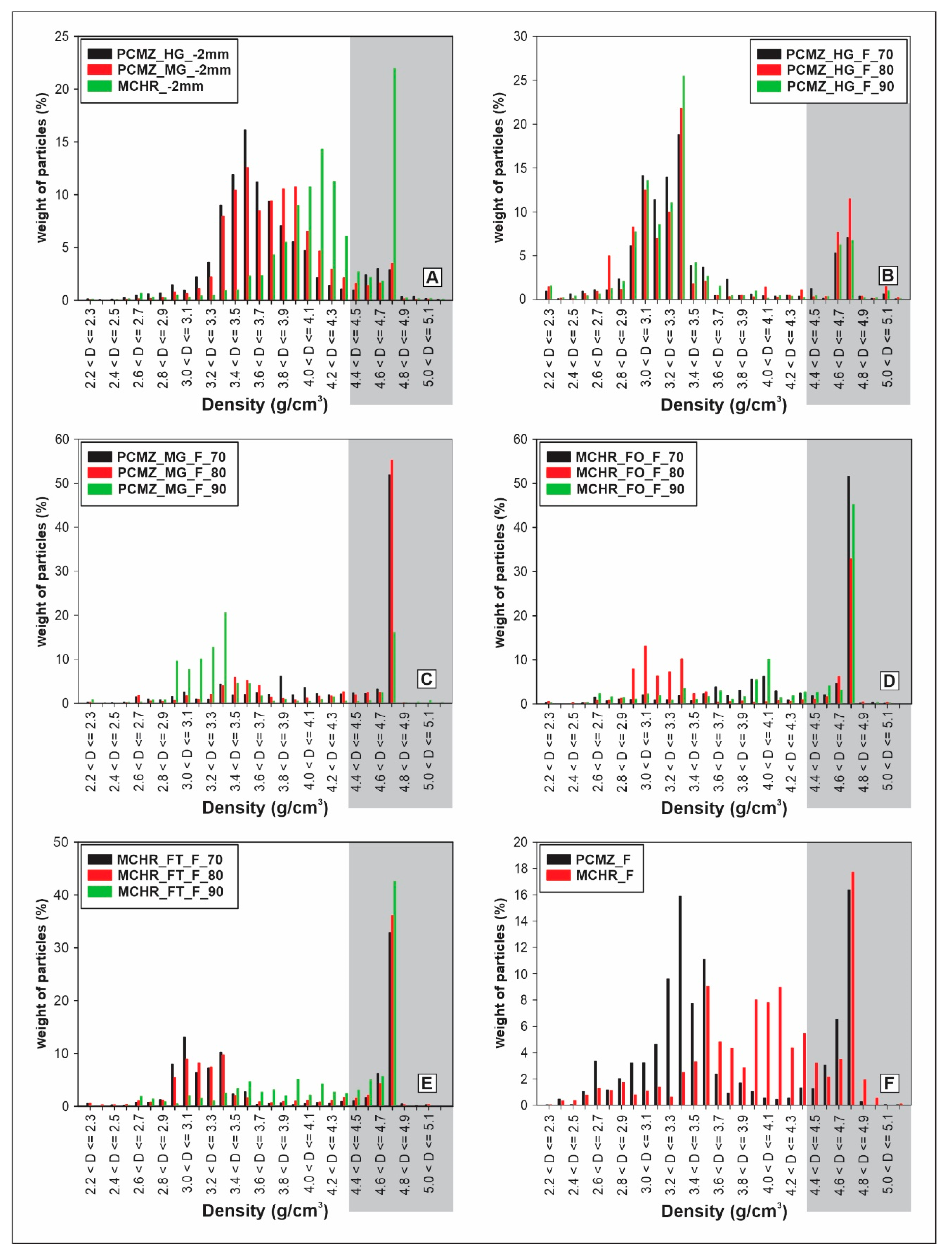
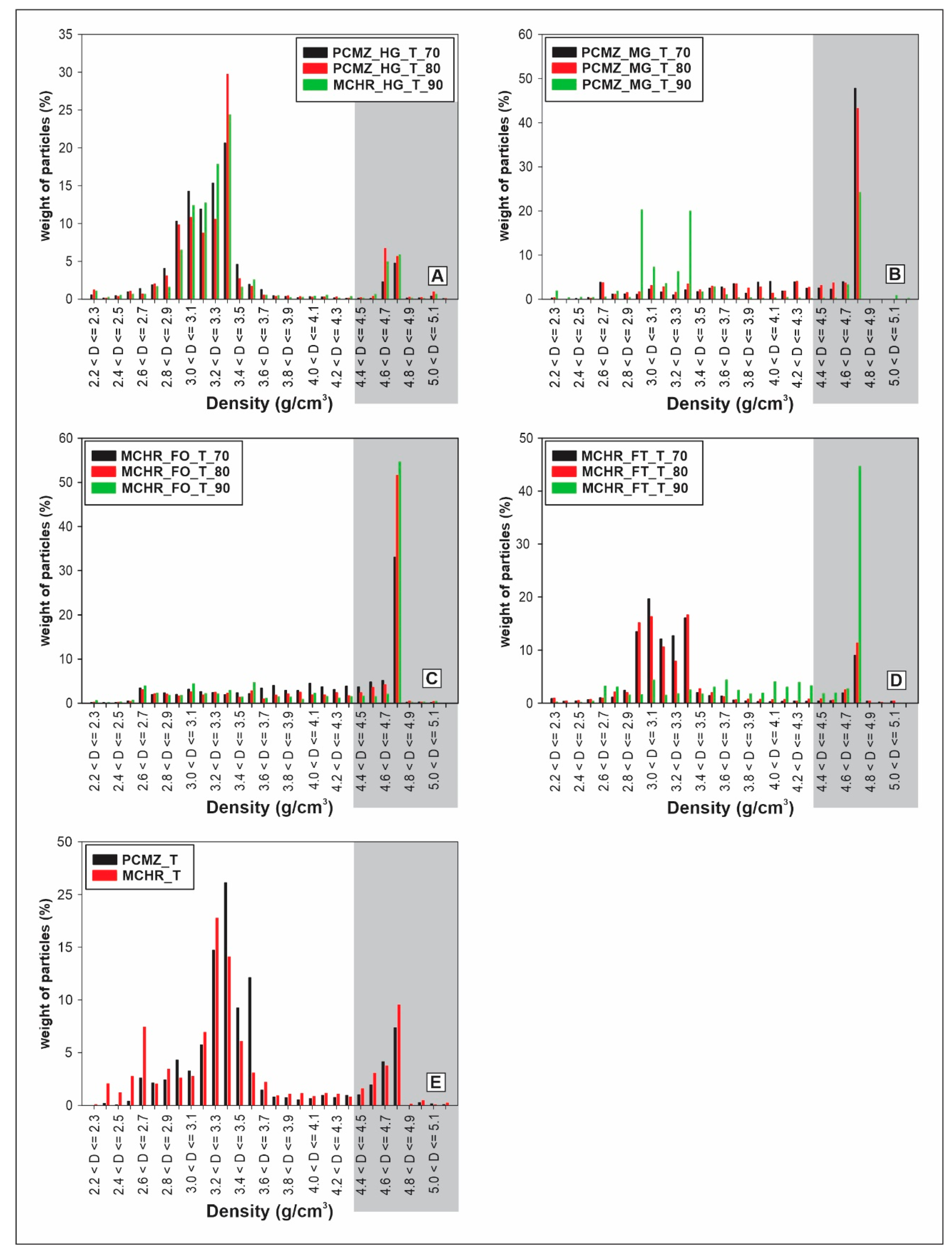
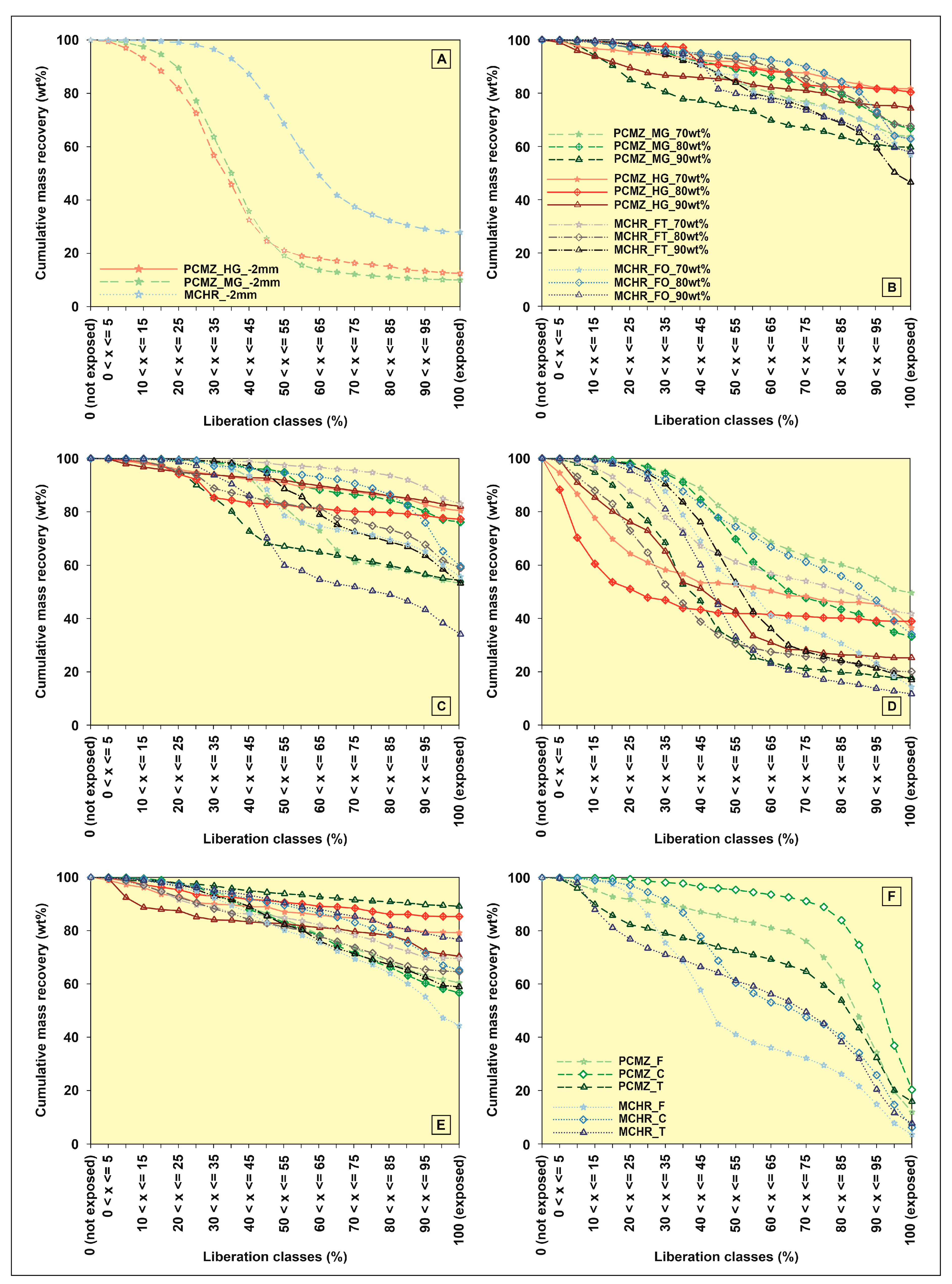
| Sample | Mass (kg) | Sample Type | Sample Description |
|---|---|---|---|
| PCMZ_MG | 12 | Geological | Medium grade, disseminated chromite ore from stock pile |
| PCMZ_HG | 12 | Geological | High grade, disseminated chromite ore from stock pile |
| MCHR | 12 | Geological | Massive chromite ore from stock pile |
| PCMZ_F | 4 | Metallurgical | Feed of PCMZ blend, flotation to recover BMS, PCMZ tailings sent to PCMZ Chrome plant |
| PCMZ_C | 4 | Metallurgical | Concentrate of PCMZ blend, flotation to recover BMS, PCMZ tailings sent to PCMZ Chrome plant |
| PCMZ_T | 4 | Metallurgical | Tailings of PCMZ blend, flotation to recover BMS, PCMZ tailings sent to PCMZ Chrome plant |
| MCHR_F | 4 | Metallurgical | Feed from Nkomati MCHR Chrome concentrator plant |
| MCHR_C | 4 | Metallurgical | Concentrate from Nkomati MCHR Chrome concentrator plant |
| MCHR_T | 4 | Metallurgical | Tailings from Nkomati MCHR Chrome concentrator plant |
| PCMZ_MG_FT | 1.50 | Metallurgical | Bench top flotation first to recover BMS, tailings sent to Wilfley shaker to concentrate chromite |
| PCMZ-HG_FT | 1.50 | Metallurgical | Bench top flotation first to recover BMS, tailings sent to Wilfley shaker to concentrate chromite |
| MCHR_FT | 1.50 | Metallurgical | Bench top flotation first to recover BMS, tailings sent to Wilfley shaker to concentrate chromite |
| Reagent and Sequence of Addition | Solution Strength (%) | Conc Active Ingredient (%) | Reagent Dosage (g/t) | Volume of Reagent to Add to Cell Per 1 kg Ore (mL) | Conditoning Time (Min) |
|---|---|---|---|---|---|
| (1) Collector: Senkol 700 | 100 | 100 | 10 | 0.01 | Add during milling |
| (2) Collector: SIBX | 1 | 100 | 100 | 10 | 1 |
| (3) Frother: Senfroth XP200 | 1 | 100 | 20 | 2 | 2 |
| (4) Depressant: Sendep 300 | 7 | 100 | 350 | 5 | 2 |
| Sample | Weight Fraction (%) | Milling Equation | R2 Value | ||
|---|---|---|---|---|---|
| 10 min | 25 min | 50 min | |||
| PCMZ_MG | 57.50 | 80.60 | 92.60 | y = 0.8369x + 53.187 | 0.8987 |
| PCMZ_HG | 39.40 | 61.70 | 89.50 | y = 1.2382x + 28.452 | 0.9936 |
| MCHR | 57.90 | 86.80 | 98.50 | y = 0.9592x + 53.890 | 0.8602 |
| Sample | Cr (ppm) | Cr2O3 Grade (%) | Cr2O3 Recovery (%) | Mass Pull (%) |
|---|---|---|---|---|
| PCMZ_MG_FT_70 wt%_F | 103,554 | - | - | - |
| PCMZ_MG_FT_70 wt%_C | 248,260 | 36 | 71 | 30 |
| PCMZ_MG_FT_70 wt%_M | 64,970 | 10 | 5 | 9 |
| PCMZ_MG_FT_70 wt%_T | 44,175 | 6 | 23 | 55 |
| PCMZ_MG_FT_80 wt%_F | 90,147 | - | - | - |
| PCMZ_MG_FT_80 wt%_C | 183,863 | 27 | 70 | 35 |
| PCMZ_MG_FT_80 wt%_M | 40,945 | 6 | 4 | 9 |
| PCMZ_MG_FT_80 wt%_T | 53,941 | 8 | 25 | 43 |
| PCMZ_MG_FT_90 wt%_F | 100,288 | - | - | - |
| PCMZ_MG_FT_90 wt%_C | 182,966 | 27 | 61 | 33 |
| PCMZ_MG_FT_90 wt%_M | 80,844 | 12 | 2 | 3 |
| PCMZ_MG_FT_90 wt%_T | 82,820 | 5 | 21 | 60 |
| PCMZ_HG_FT_70 wt%_F | 37,178 | - | - | - |
| PCMZ_HG_FT_70 wt%_C | 74,102 | 11 | 64 | 32 |
| PCMZ_HG_FT_70 wt%_M | 11,430 | 2 | 2 | 8 |
| PCMZ_HG_FT_70 wt%_T | 28,389 | 4 | 33 | 44 |
| PCMZ_HG_FT_80 wt%_F | 39,034 | - | - | - |
| PCMZ_HG_FT_80 wt%_C | 60,129 | 9 | 54 | 35 |
| PCMZ_HG_FT_80 wt%_M | 10,431 | 2 | 3 | 13 |
| PCMZ_HG_FT_80 wt%_T | 28,970 | 4 | 39 | 52 |
| Sample | Cr (ppm) | Cr2O3 Grade (%) | Cr2O3 Recovery (%) | Mass Pull (%) |
| PCMZ_HG_FT_90 wt%_F | 36,648 | - | - | - |
| PCMZ_HG_FT_90 wt%_C | 70,048 | 10 | 36 | 19 |
| PCMZ_HG_FT_90 wt%_M | 21,714 | 3 | 3 | 4 |
| PCMZ_HG_FT_90 wt%_T | 35,627 | 5 | 59 | 61 |
| MCHR_70 wt%_F | 249,049 | - | - | - |
| MCHR_70 wt%_C | 312,095 | 46 | 43 | 34 |
| MCHR_70 wt%_M | 271,042 | 40 | 9 | 9 |
| MCHR_70 wt%_T | 250,542 | 37 | 48 | 48 |
| MCHR_80 wt%_F | 248,890 | - | - | - |
| MCHR_80 wt%_C | 317,386 | 46 | 60 | 47 |
| MCHR_80 wt%_M | 253,455 | 37 | 4 | 4 |
| MCHR_80 wt%_T | 240,433 | 34 | 36 | 38 |
| MCHR_90 wt%_F | 228,904 | - | - | - |
| MCHR_90 wt%_C | 304,072 | 44 | 57 | 43 |
| MCHR_90 wt%_M | 225,858 | 33 | 4 | 5 |
| MCHR_90 wt%_T | 229,401 | 34 | 38 | 38 |
| MCHR_FT_70 wt%_F | 249,256 | - | - | - |
| MCHR_FT_70 wt%_C | 322,812 | 47 | 52 | 40 |
| MCHR_FT_70 wt%_M | 269,220 | 39 | 9 | 8 |
| MCHR_FT_70 wt%_T | 238,004 | 35 | 38 | 40 |
| MCHR_FT_80 wt%_F | 246,030 | - | - | - |
| MCHR_FT_80 wt%_C | 317,050 | 46 | 53 | 41 |
| MCHR_FT_80 wt%_M | 281,395 | 41 | 13 | 11 |
| MCHR_FT_80 wt%_T | 220,029 | 32 | 33 | 37 |
| MCHR_FT_90 wt%_F | 241,793 | - | - | - |
| MCHR_FT_90 wt%_C | 308,442 | 45 | 61 | 48 |
| MCHR_FT_90 wt%_M | 246,793 | 36 | 5 | 5 |
| MCHR_FT_90 wt%_T | 230,475 | 34 | 33 | 34 |
© 2020 by the authors. Licensee MDPI, Basel, Switzerland. This article is an open access article distributed under the terms and conditions of the Creative Commons Attribution (CC BY) license (http://creativecommons.org/licenses/by/4.0/).
Share and Cite
Dzvinamurungu, T.; Rose, D.H.; Viljoen, K.S.; Mulaba-Bafubiandi, A.F. A Process Mineralogical Evaluation of Chromite at the Nkomati Nickel Mine, Uitkomst Complex, South Africa. Minerals 2020, 10, 709. https://doi.org/10.3390/min10080709
Dzvinamurungu T, Rose DH, Viljoen KS, Mulaba-Bafubiandi AF. A Process Mineralogical Evaluation of Chromite at the Nkomati Nickel Mine, Uitkomst Complex, South Africa. Minerals. 2020; 10(8):709. https://doi.org/10.3390/min10080709
Chicago/Turabian StyleDzvinamurungu, Thomas, Derek Hugh Rose, Karel Stephanus Viljoen, and Antoine Floribert Mulaba-Bafubiandi. 2020. "A Process Mineralogical Evaluation of Chromite at the Nkomati Nickel Mine, Uitkomst Complex, South Africa" Minerals 10, no. 8: 709. https://doi.org/10.3390/min10080709
APA StyleDzvinamurungu, T., Rose, D. H., Viljoen, K. S., & Mulaba-Bafubiandi, A. F. (2020). A Process Mineralogical Evaluation of Chromite at the Nkomati Nickel Mine, Uitkomst Complex, South Africa. Minerals, 10(8), 709. https://doi.org/10.3390/min10080709







